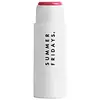What's inside
What's inside
 Key Ingredients
Key Ingredients

 Benefits
Benefits

 Concerns
Concerns

 Ingredients Side-by-side
Ingredients Side-by-side

Octyldodecanol
EmollientHydrogenated Polyisobutene
EmollientHydrogenated Poly(C6-14 Olefin)
EmollientPolyethylene
AbrasiveSilica
AbrasiveDiisostearyl Malate
EmollientSynthetic Wax
AbrasiveSynthetic Fluorphlogopite
Sorbitan Isostearate
EmulsifyingEthylene/Propylene Copolymer
AbrasiveCera Microcristallina
Emulsion StabilisingTocopherol
AntioxidantMethicone
EmollientTriethoxycaprylylsilane
BHT
AntioxidantCI 77891
Cosmetic ColorantCI 77492
Cosmetic ColorantCI 15850
Cosmetic ColorantCI 19140
Cosmetic ColorantOctyldodecanol, Hydrogenated Polyisobutene, Hydrogenated Poly(C6-14 Olefin), Polyethylene, Silica, Diisostearyl Malate, Synthetic Wax, Synthetic Fluorphlogopite, Sorbitan Isostearate, Ethylene/Propylene Copolymer, Cera Microcristallina, Tocopherol, Methicone, Triethoxycaprylylsilane, BHT, CI 77891, CI 77492, CI 15850, CI 19140
Isododecane
EmollientGlycerin
HumectantHydrogenated Polyisobutene
EmollientSorbitan Sesquioleate
EmulsifyingC9-12 Alkane
SolventBehenyl Behenate
EmollientPolyethylene
AbrasiveBis-Diglyceryl Polyacyladipate-2
EmollientIsohexadecane
EmollientPolyhydroxystearic Acid
EmulsifyingTriethylhexanoin
MaskingDisteardimonium Hectorite
StabilisingSodium Hyaluronate
HumectantEvodia Rutaecarpa Fruit Extract
Skin ConditioningTocopheryl Acetate
AntioxidantPropanediol
SolventC13-15 Alkane
SolventCoco-Caprylate/Caprate
EmollientEthylhexyl Palmitate
EmollientSilica
AbrasiveSilica Dimethyl Silylate
EmollientAlumina
AbrasiveMagnesium Oxide
AbsorbentButylene Glycol
HumectantCaprylyl Glycol
EmollientHexylene Glycol
EmulsifyingGlyceryl Linoleate
EmollientCopernicia Cerifera Wax
Euphorbia Cerifera Wax
Trihydroxystearin
Skin ConditioningIsopropyl Titanium Triisostearate
EmollientTriethoxysilylethyl Polydimethylsiloxyethyl Dimethicone
Skin ConditioningEthylene/Propylene/Styrene Copolymer
Butylene/Ethylene/Styrene Copolymer
Pentaerythrityl Tetra-Di-T-Butyl Hydroxyhydrocinnamate
AntioxidantTriethoxycaprylylsilane
Propylene Carbonate
SolventMica
Cosmetic ColorantPhenoxyethanol
PreservativeCI 77120
Cosmetic ColorantRosin
Iron Oxides
CI 77891
Cosmetic ColorantCI 45410
Cosmetic ColorantCI 15850
Cosmetic ColorantIsododecane, Glycerin, Hydrogenated Polyisobutene, Sorbitan Sesquioleate, C9-12 Alkane, Behenyl Behenate, Polyethylene, Bis-Diglyceryl Polyacyladipate-2, Isohexadecane, Polyhydroxystearic Acid, Triethylhexanoin, Disteardimonium Hectorite, Sodium Hyaluronate, Evodia Rutaecarpa Fruit Extract, Tocopheryl Acetate, Propanediol, C13-15 Alkane, Coco-Caprylate/Caprate, Ethylhexyl Palmitate, Silica, Silica Dimethyl Silylate, Alumina, Magnesium Oxide, Butylene Glycol, Caprylyl Glycol, Hexylene Glycol, Glyceryl Linoleate, Copernicia Cerifera Wax, Euphorbia Cerifera Wax, Trihydroxystearin, Isopropyl Titanium Triisostearate, Triethoxysilylethyl Polydimethylsiloxyethyl Dimethicone, Ethylene/Propylene/Styrene Copolymer, Butylene/Ethylene/Styrene Copolymer, Pentaerythrityl Tetra-Di-T-Butyl Hydroxyhydrocinnamate, Triethoxycaprylylsilane, Propylene Carbonate, Mica, Phenoxyethanol, CI 77120, Rosin, Iron Oxides, CI 77891, CI 45410, CI 15850
 Reviews
Reviews

Ingredients Explained
These ingredients are found in both products.
Ingredients higher up in an ingredient list are typically present in a larger amount.
Ci 15850 is the pigment color red. It is an azo dye and created synthetically.
Azo dyes need to be thoroughly purified before use. This allows them to be more stable and longer-lasting.
This ingredient is common in foundations, lipsticks, and blushes. This color is described as brown/orangey red.
It has many secondary names such as Red 6 and Red 7. According to a manufacturer, Red 6 usually contains aluminum.
Learn more about CI 15850Ci 77891 is a white pigment from Titanium dioxide. It is naturally found in minerals such as rutile and ilmenite.
It's main function is to add a white color to cosmetics. It can also be mixed with other colors to create different shades.
Ci 77891 is commonly found in sunscreens due to its ability to block UV rays.
Learn more about CI 77891Hydrogenated Polyisobutene is a synthetic polymer. Polymers are compounds with high molecular weight. Hydrogenated Polyisobutene is an emollient and texture enhancer.
In one study, Hydrogenated Polyisobutene showed better skin hydration levels than Caprylic/Capric Triglyceride. As an emollient, it helps keep your skin soft and hydrated by trapping moisture in.
Hydrogenated Polyisobutene is often used as a mineral oil replacement.
Learn more about Hydrogenated PolyisobutenePolyethylene is a synthetic ingredient that helps the skin retain moisture. It is a polymer.
It is also typically used within product formulations to help bind solid ingredients together and thicken oil-based ingredients. When added to balms and emulsions, it helps increase the melting point temperature.
Silica, also known as silicon dioxide, is a naturally occurring mineral. It is used as a fine, spherical, and porous powder in cosmetics.
Though it has exfoliant properties, the function of silica varies depending on the product.
The unique structure of silica enhances the spreadability and adds smoothness, making it a great texture enhancer.
It is also used as an active carrier, emulsifier, and mattifier due to its ability to absorb excess oil.
In some products, tiny microneedles called spicules are made from silica or hydrolyzed sponge. When you rub them in, they lightly polish away dead skin layers and enhance the penetration of active ingredients.
Learn more about SilicaTriethoxycaprylylsilane is a silicone used to bind and stabilize ingredients.
As an emulsifier, it helps prevent ingredients from separating. This can help elongate the shelf life of products.
Triethoxycaprylylsilane is often used to coat mineral sunscreens ingredients to help give a better feel. It also helps reduce oxidative stress in sunscreens.
Learn more about Triethoxycaprylylsilane